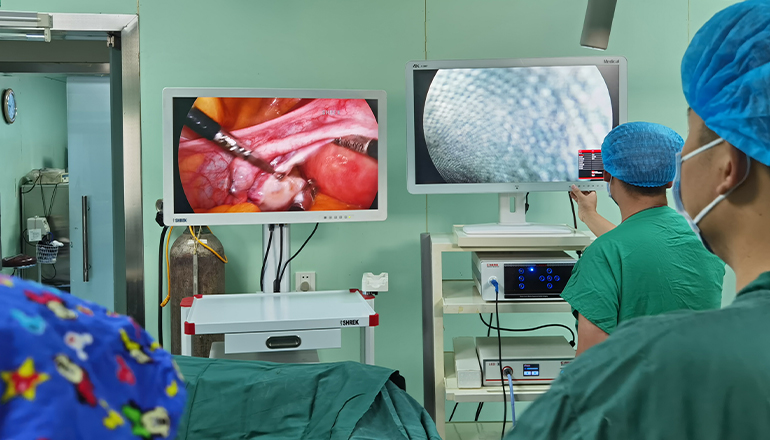- Shanghai, China
- [email protected]
- +86-21-58189111
A laparoscopic subtotal hysterectomy is a minimally invasive surgical procedure that removes the uterus but leaves the cervix intact. It is a common treatment option for women with certain gynecological conditions such as fibroids, endometriosis, and abnormal uterine bleeding. Here is some information about laparoscopic subtotal hysterectomy:
Procedure:
During a laparoscopic subtotal hysterectomy, small incisions are made in the lower abdomen. A laparoscope is then inserted through one of the incisions to visualize the pelvic organs, while other instruments are inserted through the other incisions to perform the surgery.
The surgeon detaches the uterus from the surrounding tissues and blood vessels, then divides the uterine arteries and fallopian tubes. The cervix remains in place and is left intact, and the uterus is removed through one of the small incisions in the abdomen. The incisions are then closed with sutures or staples.
Advantages:
A laparoscopic subtotal hysterectomy has several advantages over traditional open surgery. It is less invasive, which means less pain, less blood loss, and a shorter recovery time. Patients typically experience less scarring and have a lower risk of infection compared to traditional open surgery. Additionally, leaving the cervix intact may reduce the risk of pelvic organ prolapse and other postoperative complications.

Recovery:
After a laparoscopic subtotal hysterectomy, most women can return home on the same day or the day after the surgery. They may experience some mild pain, bloating, or vaginal bleeding, but these symptoms typically resolve within a few days. Patients should avoid strenuous activity for several weeks after the surgery and follow their surgeon's postoperative care instructions carefully.
Risks and complications:
Like any surgical procedure, laparoscopic subtotal hysterectomy carries some risks and potential complications. These include bleeding, infection, damage to surrounding organs, and adverse reactions to anesthesia. Patients may also experience urinary or bowel problems, sexual dysfunction, or vaginal discharge following the surgery. However, these complications are rare and can often be managed effectively with proper postoperative care.
Conclusion:
Laparoscopic subtotal hysterectomy is a safe and effective treatment option for women with certain gynecological conditions. It offers several advantages over traditional open surgery, including less pain, faster recovery, and better cosmetic results. However, like any surgical procedure, it is important for patients to carefully consider the risks and benefits before deciding to undergo the surgery. With proper training and experience, surgeons can perform this procedure safely and effectively, providing excellent outcomes for their patients.
It is important to note that a laparoscopic subtotal hysterectomy is not appropriate for all women. Some conditions, such as cancer of the uterus or cervix, may require a more extensive surgery that removes the entire uterus and cervix. Additionally, women who plan to have a future pregnancy may not be suitable candidates for this surgery as it may increase the risk of complications during childbirth.
In conclusion, laparoscopic subtotal hysterectomy is a minimally invasive surgical option that removes the uterus while leaving the cervix intact. It is a safe and effective treatment option for women with certain gynecological conditions and offers several advantages over traditional open surgery. With proper patient selection, surgical technique, and postoperative care, laparoscopic subtotal hysterectomy can provide excellent outcomes for women seeking relief from gynecological conditions.
Leave a Comments